Audiovisual Fiction and World Heritage Sites in Medium-Sized Spanish Cities: The Alhambra of Granada and the Royal Alcazar of Seville (1905–2023)
Abstract
1. Introduction
2. Materials and Methods
- Bibliographical revision regarding the representation of the image of the Alhambra and the Royal Alcazar. This is an essential stage, as it allows the authors to contextualise their work in a process initiated at the end of the 18th century.
- Bibliographical revision of the tourist history of the Alhambra and the Royal Alcazar, as well as an analysis of tourist promotion materials (guides and brochures) in order to emphasise the convergence between tourism and cinema perceived in both spaces.
- Compilation of feature films shot in both sites. For this purpose, documentary databases such as IMDb, Filmaffinity and the Filmoteca Española were used. The corpus is made up of 68 films shot in Granada, and 52 in Seville (Appendix A, Table A1 and Table A2). Documentaries and television series are excluded.
- Integration of the main parameters of these films in a database (director, year of release, nationality of the production).
- Film viewing and identification of scenes (hereafter referred to as clips). Creation of a clips file for each film.
- Clips classification into spatial categories: (a) credit titles, indoor shots or other city shots; (b) city shots without showing the site; (c) site shots; and (d) shots from viewpoints showing the exterior of the site (Alhambra), or shots from the site revealing other heritage elements (Royal Alcazar).
- Quantification of clips duration (in seconds).
- Geolocation of clips type (c) and (d). Use of decimal coordinates for georeferencing, which allows subsequent preparation of cartographies for both sites.
3. The Image of the Alhambra and the Royal Alcazar during the 19th Century: Painting, Engraving and Photography, Precursors of Audiovisual Fiction
4. Audiovisual Fiction in the Alhambra and the Royal Alcazar: Results and Discussion
4.1. Evolution of Filming at the Alhambra and the Royal Alcazar
4.1.1. Pre-Civil War Cinematography (1905–1936)
4.1.2. Postwar and Early Francoism (1937–1954)
4.1.3. Openness and Late-Francoism (1955–1975)
4.1.4. Spanish Political Transition and the Early Years of Democracy (1976–1999)
4.1.5. 21st Century (2000–2023)
4.2. Spatial Distribution of Locations
5. Conclusions
Author Contributions
Funding
Institutional Review Board Statement
Informed Consent Statement
Conflicts of Interest
Appendix A
| Film | Year | Director | Shooting Inside the Alhambra |
|---|---|---|---|
| Espagne | 1905 | Alice Guy | Yes |
| Der Tod in Sevilla | 1913 | Urban Gad | Unknown |
| La Gitanilla | 1914 | Louis Feuillade | Unknown |
| Christophe Colomb | 1916 | Gérard Bourgeois | Yes |
| Sangre y Arena | 1916 | Vicente Blasco Ibáñez/Max André | Yes |
| La España Trágica | 1918 | Rafael Salvador | Yes |
| El Dorado | 1921 | Marcel L’Herbier | Yes |
| Militona et Pedrucho | 1922 | Henri Vorins | Unknown |
| Curro Vargas | 1923 | José Buchs | Yes |
| El niño de oro | 1925 | José María Granada | Unknown |
| Amapola | 1926 | José Martín | Unknown |
| Raza de hidalgos | 1927 | Tony D’Algy | Unknown |
| Los claveles de la Virgen | 1929 | Florián Rey | Yes |
| La copla andaluza | 1929 | Ernesto González | Unknown |
| Isabel de Solís, Reina de Granada | 1931 | José Buchs | Unknown |
| Alhambra (El Suspiro del Moro) | 1936 | Antonio Graciani | Unknown |
| María de la O | 1939 | Francisco Elías | Yes |
| Forja de almas | 1943 | Eusebio Fernández Ardavín | Yes |
| El doncel de la Reina | 1944 | Eusebio Fernández Ardavín | Unknown |
| Serenata Española | 1947 | Juan de Orduña | Yes |
| Alhambra | 1949 | Juan Vilá Vilamala | Unknown |
| Cuentos de la Alhambra | 1950 | Florián Rey | Yes |
| Debla, la virgen gitana | 1951 | Ramón Torrado | Yes |
| Rendez-vous à Grenade | 1951 | Richard Pottier | Unknown |
| Decameron Nights | 1952 | Hugo Fregonese | Yes |
| La hermana San Sulpicio | 1952 | Luis Lucia | Yes |
| Violettes Impériales | 1952 | Richard Pottier | Yes |
| El seductor de Granada (A la buena de Dios) | 1953 | Lucas Demare | Yes |
| ¡Todo es posible en Granada! | 1954 | José Luis Sáenz de Heredia | Yes |
| Nuits Andalouses | 1954 | Maurice Cloche | Yes |
| Para siempre | 1955 | Tito Davison | Yes |
| Soledad | 1957 | Enrico Gras/Mario Craveri | Yes |
| It started with a kiss | 1958 | George Marshall | No |
| Taxi, roulotte et corrida | 1958 | André Hunebelle | Yes |
| The 7th voyage of Sinbad | 1958 | Nathan H. Juran | Yes |
| Honeymoon | 1959 | Michael Powell | Yes |
| Scent of Mystery | 1960 | Jack Cardiff | Yes |
| Aprendiendo a morir | 1961 | Pedro Lazaga | No |
| Un puente sobre el tiempo | 1963 | José Luis Merino | No |
| Gitana | 1965 | Joaquín Bollo Muro | No |
| En Andalucía nació el amor | 1966 | Enrique López Eguiluz | Yes |
| Cervantes | 1967 | Vincent Sherman | Yes |
| Granada, addio! | 1967 | Marino Girolami | Yes |
| No le busques tres pies… | 1967 | Pedro Lazaga | Unknown |
| Rififí ad Amsterdam | 1967 | Sergio Grieco | Unknown |
| Cuidado con las señoras | 1968 | Julio Buchs | No |
| La esclava del paraíso | 1968 | José María Elorrieta | Yes |
| Fortunata y Jacinta | 1970 | Angelino Fons | Yes |
| La folie des Grandeurs | 1971 | Gérard Oury | Yes |
| La novicia rebelde | 1971 | Luis Lucia | Yes |
| Rocío y los detonadores | 1972 | Fernando García Tola | Yes |
| El insólito embarazo de los Martínez | 1974 | Javier Aguirre | No |
| The Golden Voyage of Sinbad | 1974 | Gordon Hessler | Yes |
| El último guateque | 1976 | Juan José Porto | No |
| ¡Todo es posible en Granada! | 1982 | Rafael Romero Marchent | Yes |
| El último guateque II | 1987 | Juan José Porto | No |
| El Lute II: Mañana seré libre | 1988 | Vicente Aranda | No |
| Días contados | 1994 | Imanol Uribe | No |
| Dos hombres y una mujer | 1994 | Juan José Porto | Unknown |
| La hermana | 1994 | Juan José Porto | No |
| The disappearance of García Lorca | 1996 | Marcos Zurinaga | No |
| Alice et Martin | 1998 | André Téchiné | Yes |
| Gitano | 2000 | Manuel Palacios | Yes |
| La luz prodigiosa | 2003 | Miguel Hermoso | No |
| Assassin’s Creed | 2016 | Justin Kurzel | Yes |
| Tadeo Jones 2: El secreto del Rey Midas | 2017 | Enrique Gato/David Alonso | Yes |
| Granada nights | 2021 | Abid Kahn | No |
| Film | Year | Director | Shooting Inside the Alcazar |
|---|---|---|---|
| Le coffret de Tolède | 1914 | Louis Feuillade | Yes |
| Les fiancés de Séville | 1914 | Louis Feuillade | Yes |
| Sangre y Arena | 1916 | Vicente Blasco Ibáñez/Max André | Yes |
| Christophe Colomb | 1916 | Gérard Bourgeois | Yes |
| La terre des taureaux | 1923 | Jeanne Roques | No |
| Currito de la Cruz | 1926 | Alejandro Pérez Lugín | Yes |
| El embrujo de Sevilla | 1930 | Benito Perojo | Unknown |
| Adieu les beaux jours | 1933 | André Beucler/Johannes Meyer | Unknown |
| Currito de la Cruz | 1936 | Fernando Delgado | Unknown |
| La Reina Mora | 1937 | Eusebio Fernández Ardavín | Yes |
| Suspiros de España | 1938 | Benito Perojo | No |
| María de la O | 1939 | Francisco Elías | No |
| Tierra y Cielo | 1941 | Eusebio Fernández Ardavín | Yes |
| La Blanca Paloma | 1942 | Claudio de la Torre | Yes |
| El frente de los suspiros | 1942 | Juan de Orduña | Yes |
| Olé, torero | 1948 | Benito Perojo | No |
| Jalisco canta en Sevilla | 1949 | Fernando de Fuentes | No |
| Una cubana en España | 1951 | Luis Bayón Herrera | Yes |
| La hermana San Sulpicio | 1952 | Luis Lucia | Yes |
| Châteaux en Espagne | 1954 | René Wheeler | No |
| Nuits Andalouses | 1954 | Maurice Cloche | No |
| Suspiros de Triana | 1955 | Ramón Torrado | No |
| ¿Dónde vas, Alfonso XII? | 1959 | Luis César Amadori | Yes |
| La femme et le pantin | 1959 | Julien Duvivier | Yes |
| Bajo el cielo andaluz | 1960 | Arturo Ruiz Castillo | No |
| Feria en Sevilla | 1962 | Ana Mariscal | No |
| Lawrence of Arabia | 1962 | David Lean | Yes |
| Camino del Rocío | 1966 | Rafael Gil | No |
| En Andalucía nació el amor | 1966 | Enrique López Eguiluz | No |
| La novicia rebelde | 1971 | Luis Lucia | No |
| The Wind and the Lion | 1975 | John Milius | Yes |
| Cet obscur objet du désir | 1978 | Luis Buñuel | No |
| Reds | 1981 | Warren Beatty | Yes |
| Los alegres bribones | 1982 | Pancho Bautista | No |
| Carmen | 1984 | Francesco Rosi | Yes |
| Bolero | 1984 | John Derek | Yes |
| ‘Non’ ou A Vã Glória de Mandar | 1990 | Manoel de Oliveira | Yes |
| Ispanskaya aktrisa dlya russkogo ministra | 1990 | Sebastián Alarcón | No |
| 1492: The conquest of Paradise | 1992 | Ridley Scott | Yes |
| Nadie conoce a nadie | 1999 | Mateo Gil | No |
| El caballero Don Quijote | 2002 | Manuel Gutiérrez Aragón | Yes |
| Carmen | 2003 | Vicente Aranda | No |
| Kingdom of Heaven | 2005 | Ridley Scott | Yes |
| Olè | 2006 | Carlo Vanzina | No |
| The limits of control | 2009 | Jim Jarmusch | No |
| Appelsinpiken | 2009 | Eva Dahr | Yes |
| Knight and Day | 2010 | James Mangold | No |
| Ispansi! | 2011 | Carlos Iglesias | Yes |
| Blancanieves | 2013 | Pablo Berger | No |
| Ocho apellidos catalanes | 2015 | Emilio Martínez-Lázaro | No |
| Life itself | 2018 | Dan Fogelman | No |
| Una vez más | 2019 | Guillermo Rojas | No |
References
- Barrado-Timón, D.; Palacios, A.; Hidalgo-Giralt, C. Medium and Small Cities, Culture and the Economy of Culture. A Review of the Approach to the Case of Spain in Light of International Scientific Scholarship. Sustainability 2020, 12, 7321. [Google Scholar] [CrossRef]
- Barrado-Timón, D.; García, A.P.; Varela, C.V.; Giralt, C.H.; Cala, A.S. Culture and Tourism in Medium-Sized Cities. Dialogues for a Post-Covid Scenario; Universidad de Castilla—La Mancha: Ciudad Real, Spain, 2022. [Google Scholar] [CrossRef]
- Cebrián Abellán, F.; Panadero Moya, M. (Eds.) Ciudades Medias: Formas de Expansión Urbana; Biblioteca Nueva: Madrid, Spain, 2013. [Google Scholar]
- Manuel, C.; Gámir, A.; Aertsen, V. Ciudad y ficción audiovisual: Enfoques para un análisis geográfico. Bol. De La Asoc. De Geogr. Esp. 2022, 95, bage3328. [Google Scholar] [CrossRef]
- Alaminos, E. Así es Madrid en el Cine; El Gran Caid—Museo de Arte Contemporáneo: Madrid, Spain, 2008. [Google Scholar]
- Aubert, J.-P. Madrid à L’écran (1939–2000); Presses Universitaires de France: Paris, France, 2013; Available online: https://www.cairn.info/madrid-a-l-ecran--9782130625360.htm (accessed on 22 December 2022).
- Sánchez, J.-L. Madrid: De la españolada desarrollista al cosmopolitismo de la movida. In Ciudades de Cine; García Gómez, F., Pavés, G., Eds.; Cátedra: Madrid, Spain, 2014; pp. 207–226. [Google Scholar]
- Aertsen, V.; Gámir, A.; Manuel, C.; Mélgar, L. Analysis of a Filmed Urban Area through a GIS Tool: Madrid Movie Map. In Media’s Mapping Impulse; Lukinbeal, C., Ed.; Franz Steiner Verlag: Stuttgart, Germany, 2019; pp. 213–234. [Google Scholar]
- Alfeo, J.C.; Deltell, L. (Eds.) Madrid. Ciudad de Imágenes; Fragua: Madrid, Spain, 2022. [Google Scholar]
- Caparrós, J.M. Barcelona, escenario y protagonista de películas. In Ciudades Europeas en el Cine; Camarero, G., Ed.; Akal: Madrid, Spain, 2013; pp. 47–65. [Google Scholar]
- Osácar, E. Barcelona, Movie Walks; Diéresis y Barcelona City Council: Barcelona, Spain, 2013. [Google Scholar]
- Antoniazzi, S. La ciudad filmada: Cine, espacio e historia urbana. Biblio3W Rev. Bibliogr. De Geogr. Y Cienc. Soc. 2019, 24, 27278. [Google Scholar]
- Dalmau, R.; Galera, A. Ciudades del Cine; Raima: Barcelona, Spain, 2007. [Google Scholar]
- Mennel, B.C. Cities and Cinema; Routledge: London, UK, 2008. [Google Scholar]
- Koeck, R. Cine-Scapes. Cinematic Spaces in Architecture and Cities; Routledge: New York, NY, USA; London, UK, 2013. [Google Scholar]
- Camarero, G. (Ed.) Ciudades Europeas en el Cine; Akal: Madrid, Spain, 2013. [Google Scholar]
- Camarero, G. (Ed.) Ciudades Americanas en el Cine; Akal: Madrid, Spain, 2017. [Google Scholar]
- García Gomez, F.; Pavés, G.M. (Eds.) Ciudades de Cine; Cátedra: Madrid, Spain, 2014. [Google Scholar]
- De Uña, J.M. Historias de Una Ciudad y El Cine; Fancy Ediciones: Valladolid, Spain, 2002. [Google Scholar]
- Ventajas Dote, F. Málaga, plató de cine: El auge de los rodajes en la década de 1960. Andal. En La Hist. 2008, 19, 98–103. [Google Scholar]
- Martínez Fernández, B. Córdoba En El Cine; Colección Comunicación 7; Excma, Diputacion Provincial: Cordoba, Spain, 1991. [Google Scholar]
- Jurado, R. El Cine en Córdoba Durante el Franquismo; Diputación de Córdoba, Delegación de Cultura: Sevilla, Spain, 2003. [Google Scholar]
- Jiménez, E.d.M. Turismo Inducido a Través del cine: Génesis del Imaginario Romántico de Córdoba en el Contexto Cinematográfico Español (1920–1930). Ph.D. Thesis, Universidad Carlos III de Madrid, Madrid, Spain, 2012. [Google Scholar]
- Sánchez Navas, J. El Trasvase de Elementos Significantes Entre la Ciudad Turística de Benidorm y la Ficción Audiovisual: El Cine Español Como Caso de Estudio. Ph.D. Thesis, Universidad de Alicante, Alicante, Spain, 2016. [Google Scholar]
- García Moreno, A. Cine, Ciudad y Patrimonio en Torremolinos (1959–1979); Universidad de Málaga: Malaga, Spain, 2017. [Google Scholar]
- Delgado, J.F. El Cine. Colección Cosas de Sevilla; Grupo Andaluz de Ediciones: Sevilla, Spain, 1981. [Google Scholar]
- Fabián, J. Sevilla y el cine. Siglo Que Viene Rev. De Cult. 1995, 24–25, 67–70. [Google Scholar]
- Utrera, R. (Ed.) Imágenes Cinematográficas de Sevilla; Padilla Libros: Sevilla, Spain, 1997. [Google Scholar]
- Utrera, R. El cine y Sevilla. Siglo Que Viene Rev. De Cult. 1995, 24, 71–75. [Google Scholar]
- Checa, A. Imágenes Cinematográficas de Sevilla; Biblioteca Virtual Miguel de Cervantes: Alicante, Spain, 2001. [Google Scholar]
- Navarrete, R. Sevilla, Plató de Cine, 1st ed.; Turismo de Sevilla, Convention Bureau: Sevilla, Spain, 2006. [Google Scholar]
- Zoido Salazar, S. Sevilla en el Cine; Spink: Granada, Spain, 2013. [Google Scholar]
- Hernández, V.A. Sevilla: Del tipismo folclórico al thriller tenebrista. In Ciudades de Cine; Catedra: Madrid, Spain, 2014; pp. 349–362. [Google Scholar]
- Lara, J.; García, A. Cine y patrimonio urbano. El paisaje granadino en el imaginario del celuloide. In Ciudad, Territorio y Paisaje. Reflexiones para un Debate Multidisciplinary; Cornejo Nieto, C., Morán Saéz, J., Prada Trigo, J., Eds.; CSIC: Madrid, Spain, 2010; pp. 393–407. [Google Scholar]
- Díaz Box, J. Un recorrido histórico por la Granada cinematográfica. In Cine y Ciudades. Imágenes e Imaginarios en Ambientes Urbanos; Ventura, F.S., Ed.; Intramar Ediciones: Santa Cruz de Tenerife, Spain, 2011; pp. 223–234. [Google Scholar]
- Zoido Salazar, S. Granada en el Cine; Spink: Granada, Spain, 2015. [Google Scholar]
- Monferrer, E.B.; Arda, Z.; Fernández, C.F. Comunicación e historia al servicio de la proyección territorial: La imagen oriental de la ciudad de Granada. Hist. Comun. Soc. 2013, 18, 893–904. [Google Scholar] [CrossRef]
- De Olazábal, J.R. El audiovisual surcoreano en España: Granada como ludo-mundo en la serie Recuerdos de la Alhambra. Atalante Rev. De Estud. Cine. 2020, 29, 53–66. [Google Scholar]
- Hernández Ramírez, J. Turismo inducido. La configuración de la imagen turística de Sevilla a través del cine comercial. In Congreso Internacional Patrimonio, Desarrollo Rural y Turismo en el Siglo XXI; Escuela Universitaria Francisco Maldonado de Osuna: Sevilla, Spain, 2004; Volume 2, pp. 503–515. [Google Scholar]
- Oviedo-Garcia, M.Á.; Castellanos-Verdugo, M.; Trujillo-García, M.A.; Mallya, T. Film-induced tourist motivations. The case of Seville (Spain). Curr. Issues Tour. 2016, 19, 713–733. [Google Scholar] [CrossRef]
- Puche-Ruiz, M.C. Imagen e Identidad Territorial. El Cine Como Instrumento de Análisis del Turismo en Andalucía (1905–1975). Ph.D. Thesis, Universidad de Sevilla, Sevilla, Spain, 2019. [Google Scholar]
- Puche-Ruiz, M.C. El Sueño de Andalucía en el Primer Cine Francés: (1909–1929). In Arte y Turismo: La Identidad Andaluza en la Configuración Cultural de Europa, 1st ed.; Editorial de Universidad de, Sevilla; Méndez, L., Plaza, R., Eds.; Universidad de Sevilla: Sevilla, Spain, 2019; pp. 175–192. [Google Scholar]
- Puche-Ruiz, M.C. El Díptico Turístico de Musidora (1922–1924): Propaganda Cinematográfica en el marco de la Comisaría Regia; Universidad de Sevilla, Departamento de Periodismo I: Sevilla, Spain, 2020. [Google Scholar]
- Puche-Ruiz, M.C.; Fernández, A. Iconic architecture or theme park? Seville’s cinematographic reinvention for tourism purposes (1914–1930). In Tourism Fictions, Simulacra and Virtualities; Graburn, N., Gravari-Barbas, M., Staszak, J.-F., Eds.; Routledge: London, UK, 2020; pp. 86–104. Available online: https://www.taylorfrancis.com/books/9780429278952/chapters/10.4324/9780429278952-5 (accessed on 23 December 2022).
- Osácar, E.; Puche-Ruiz, M.C.; Martínez, S. Hitos turísticos urbanos y su representación en las producciones audiovisuales: El caso de España (2000–2021). Bol. De La Asoc. De Geogr. Esp. 2022, 95, 6. [Google Scholar] [CrossRef]
- Osácar, E.; Fraiz, J.A.; Araújo-Vilá, N. Imágenes turísticas de las ciudades españolas a partir de la ficción audiovisual. Bol. De La Asoc. De Geogr. Esp. 2022, 95, 7. [Google Scholar] [CrossRef]
- Cohen, J. Promotion of Overseas Tourism through Media Fiction. In Tourism Services Marketing: Advances in Theory and Practice; Joseph, W.B., Moutinho, L., Eds.; Association and Cleveland State University: Cleveland, OH, USA, 1986. [Google Scholar]
- Riley, R.; Van Doren, D. Movies as Tourism Promotion: A Pull Factor in a Push Location. Tour. Manag. 1992, 13, 267–274. [Google Scholar] [CrossRef]
- Tooke, N.; Baker, M. Seeing Is Believing: The Effect of Film on Visitor Numbers to Screened Locations. Tour. Manag. 1996, 17, 87–94. [Google Scholar] [CrossRef]
- Riley, R.; Baker, D.; Van Doren, C. Movie Induced Tourism. Ann. Tour. Res. 1998, 25, 919–935. [Google Scholar] [CrossRef]
- Beeton, S. Smiling for the Camera: The Influence of Film Audiences on a Budget Tourism Destination. Tour. Cult. Commun. 2001, 3, 15–25. [Google Scholar] [CrossRef]
- Mestre, R.; Rey Reguillo, A.; Stanishevski, K. The Image of Spain as Tourist Destination Built Through Fictional Cinema. J. Travel Tour. Mark. 2008, 24, 185–194. [Google Scholar] [CrossRef]
- Nieto Ferrando, J.J.; Rey Reguillo, A.; Afinoguénova, E. Narración, Espacio y Emplazamiento Turístico En El Cine Español de Ficción (1951–1977). Rev. Lat. De Comun. Soc. 2015, 70, 584–610. [Google Scholar] [CrossRef]
- Beeton, S. Film-Induced Tourism; Channel View Publications: Bristol, UK, 2005. [Google Scholar]
- Hudson, S.; Ritchie, J.B. Promoting Destinations via Film Tourism: An Empirical Identification of Supporting Marketing Initiatives. J. Travel Res. 2006, 44, 387–396. [Google Scholar] [CrossRef]
- Tzanelli, R. Constructing the ‘Cinematic Tourist’: The ‘Sign Industry’ of The Lord of the Rings. Tour. Stud. 2004, 4, 21–42. [Google Scholar] [CrossRef]
- Connell, J.; Meyer, D. Balamory Revisited: An Evaluation of the Screen Tourism Destination-Tourist Nexus. Tour. Manag. 2009, 30, 194–207. [Google Scholar] [CrossRef]
- Gajic, T.; Radovanovic, M.; Tretiakova, T.; Syromiatnikova, J. Creating Brand Confidence to gastronomic Consumers through social Networks—A Report from Novi Sad. J. Place Manag. Dev. 2021, 14, 32–42. [Google Scholar] [CrossRef]
- O’Connor, N.; Flanagan, S.; Gilbert, D. A Film Marketing Action Plan for Film Induced Tourism Destinations: Using Yorkshire as a Case Study; Lambert Academic Publishing: Saarbrücken, Germany, 2010. [Google Scholar]
- Roesch, S. The Experiences of Film Location Tourists; Channel View Publications: Bristol, UK, 2009. [Google Scholar]
- Rui, A.; Banha, F.; Banha, F.M. Video-Induced Tourism in Central Portugal: Production and Impact of Promotional Videos. Tour. Manag. Stud. 2022, 18, 41–50. [Google Scholar] [CrossRef]
- Vela Nieto, Á. Triana, un Barrio de Cine; RD Editores: Sevilla, Spain, 2008. [Google Scholar]
- Romero Ternero, M.J.; Puche-Ruiz, M.C. La Plaza de España de Sevilla. De decorado simbólico a tesoro turístico-cinematográfico. J. Tour. Herit. Res. JTHR 2020, 3, 427–453. [Google Scholar]
- Aertsen, V.; Gámir, A.; Manuel, C. La imagen cinematográfica de la Plaza Mayor de Madrid. Ciudad Territ. Estud. Territ. 2018, 197, 539–556. [Google Scholar]
- Piñar Samos, J. El pasado como motivo. La Alhambra en la producción fotográfica europea (1840–1888). Cuad. De La Alhambra 2009, 44, 8–49. [Google Scholar]
- Romero, A.; Mateo, S. El cine y la Alhambra. In V Congreso Internacional de Historia y Cine: Escenarios del cine Histórico; Camarero, G., Sánchez Barba, F., Eds.; Universidad Carlos III de Madrid, Instituto de Cultura y Tecnología: Getafe, Spain, 2017; pp. 803–815. [Google Scholar]
- Del Rey, A. Sortilegios y prodigios como antídotos de realidad. Todo es posible en Granada. In El Destino se Disculpa. El Cine de José Luis Sáenz de Heredia; Castro de Paz, J.L., Nieto Ferrando, J., Eds.; Ediciones de la Filmoteca: Valencia, Spain, 2011; pp. 149–159. [Google Scholar]
- Gómez-Morales, B.; Nieto-Ferrando, J.; Sánchez-Castillo, S. (Re)Visiting Game of Thrones: Film-Induced Tourism and Television Fiction. J. Travel Tour. Mark. 2022, 39, 73–86. [Google Scholar] [CrossRef]
- Calleja, R. Apología Turística de España; Dirección General del Turismo: Madrid, Spain, 1943. [Google Scholar]
- Crang, M. Placing Jane Austen, Displacing England: Touring between Book, History and Nation. In Jane Austen and Co.: Remaking the Past in Contemporary Culture; Pucci, S., Thompson, J., Eds.; SUNY Press: New York, NY, USA, 2003; pp. 111–132. Available online: http://www.core.ac.uk/reader/66773 (accessed on 19 February 2023).
- Martin-Jones, D. Film Tourism as Heritage Tourism: Scotland, Diaspora and The Da Vinci Code (2006). New Rev. Film. Telev. Stud. 2014, 12, 156–177. [Google Scholar] [CrossRef]
- Sargent, A. The Darcy Effect: Regional Tourism and Costume Drama. Int. J. Herit. Stud. 1998, 4, 177–186. [Google Scholar] [CrossRef]
- Faulkner, S. Spanish Heritage Cinema. In The Europeanness of European Cinema: Identity, Meaning, Globalization; Harrod, M., Liz, M., Timoshkina, A., Eds.; I.B. Tauris: London, UK, 2015; pp. 213–226. [Google Scholar] [CrossRef]
- Higson, A. English Heritage, English Cinema: Costume Drama since 1980; Oxford University Press: Oxford, UK; New York, NY, USA, 2003. [Google Scholar]
- O’Leary, A. Towards World Heritage Cinema (Starting from the Negative). In Screening European Heritage; Cooke, P., Stone, R., Eds.; Palgrave Macmillan: London, UK, 2016; pp. 63–84. [Google Scholar] [CrossRef]
- Schiavone, R.; Reijnders, S.; Brandellero, A. Beneath the storyline’: Analysing the role and importance of film in the preservation and development of Scottish heritage sites. Int. J. Herit. Stud. 2022, 28, 1107–1120. [Google Scholar] [CrossRef]
- Orr, A. Plotting Jane Austen: Heritage Sites as Fictional Worlds in the Literary Tourist’s Imagination. Int. J. Herit. Stud. 2018, 24, 243–255. [Google Scholar] [CrossRef]
- Higson, A. Historical Film in Europe: The Trasnational Productions, Circulations and Reception of ‘National’ Heritage Drama. In Screening European Heritage. Creating and Consuming History on Films; Cooke, P., Stone, R., Eds.; Palgrave Macmillan: London, UK, 2016; pp. 86–104. [Google Scholar]
- Bąkiewicz, J.; Leask, A.; Barron, P.; Rakić, T. Management Challenges at Film-Induced Tourism Heritage Attractions. Tour. Plan. Dev. 2017, 14, 548–566. [Google Scholar] [CrossRef]
- Martin-Fuentes, E.; Nieto-Ferrando, J.; Mariné-Roig, E.; Ferrer-Rosell, B. From Blockbuster to Neighbourhood Buster: The Effect of Films on Barcelona. Sustainability 2020, 12, 2290. [Google Scholar] [CrossRef]
- Lopez, L.; Nicosia, E.; González, R.C.L. Sustainable Tourism: A Hidden Theory of the Cinematic Image? A Theoretical and Visual Analysis of the Way of St. James. Sustainability 2018, 10, 3649. [Google Scholar] [CrossRef]
- Nieto-Ferrando, J.J. Tourist Destination Placement in Fiction Films: An Applied Research Proposal. Comun. Soc. 2020, 33, 1–17. [Google Scholar] [CrossRef]
- Galera Andreu, P. La Imagen Romántica de la Alhambra; Ediciones El Viso: Madrid, Spain, 1992. [Google Scholar]
- Montes Martín, J.C. Sorolla y Sevilla; Arte Hispalense, no. 107; Diputación de Sevilla, Servicio de Archivo y Publicaciones: Sevilla, Spain, 2015. [Google Scholar]
- Pérez Calero, G. Virgilio Mattoni y el Real Alcázar de Sevilla: Entre la erudición y la pintura. Lab. De Arte Rev. Del Dep. De Hist. Del Arte 2020, 32, 413–432. [Google Scholar] [CrossRef]
- Rodríguez Ruiz, D.; Pérez Gallardo, H. (Eds.) Mirar la Arquitectura. Fotografía Monumental en el Siglo XIX; Ministerio de Cultura, Biblioteca Nacional: Madrid, Spain, 2015. [Google Scholar]
- Yáñez Polo, M.V.M. Casajús, Introductor de La Litografía y El Daguerrotipo En Sevilla: Incluye Las 13 Primeras Litografías Realizadas En Sevilla; Colección Casajús, no. 1; Sociedad de Historia de la Fotografía Española: Sevilla, Spain, 1987. [Google Scholar]
- Fundación Mapfre. Una Imagen de España. Fotógrafos Estereoscopistas Franceses (1856–1867); TF Editores: Madrid, Spain, 2011. [Google Scholar]
- Butler, R.W. The Influence of the Media in Shaping International Tourist Patterns. Tour. Recreat. Res. 1990, 15, 46–53. [Google Scholar] [CrossRef]
- Menéndez Robles, M.L. El Marqués de la Vega de Inclán y los Orígenes del Turismo en España; Ministerio de Industria, Turismo y Comercio, División de Información, Documentación y Publicaciones: Madrid, Spain, 2008. [Google Scholar]
- Comisaría Regia del Turismo y Cultura Artística. La Comisaría Regia del Turismo en la Alhambra de Granada; Artes Gráficas Mateu: Madrid, Spain, 1915. [Google Scholar]
- Viñes Millet, C. La visión de la Alhambra en la prensa granadina del XIX. Cuad. De Arte De La Univ. De Granada 1984, 16, 389–426. [Google Scholar]
- Álvarez Lopera, J. La Alhambra entre la conservación y la restauración (1905–1915). Cuad. De Arte De La Univ. De Granada 1977, 14, 7–238. [Google Scholar]
- Martín Céspedes, M.Á. La intervención de Torres Balbás en la Alhambra. Pap. Del Partal Rev. De Restauración Monum. 2008, 4, 63–70. [Google Scholar]
- Ruiz Romero, M. Los Conservadores Municipales Del Real Alcázar; Patronato del Real Alcázar de Sevilla: Sevilla, Spain, 2003. [Google Scholar]
- Cabeza Méndez, J.M. El Alcázar contemporáneo. Apunt. Del Real Alcázar De Sevilla 2012, 14, 154–173. [Google Scholar]
- Strauven, W. (Ed.) The Cinema of Attractions Reloaded; Amsterdam University Press: Amsterdam, The Netherlands, 2006; Available online: https://www.jstor.org/stable/j.ctt46n09s (accessed on 13 February 2023).
- Vallejo Pousada, R. Economía e historia del turismo español del siglo XX. Hist. Contemp. 2002, 25, 203–232. [Google Scholar]
- Pellejero Martínez, C. La política turística en España: Una perspectiva histórica. Mediterr. Econ. 2004, 5, 268–284. [Google Scholar]
- Correyero Ruiz, B. La administración turística española entre 1936 y 1951. El turismo al servicio de la propaganda política. Estud. Tur. 2005; 163–164, 55–79. [Google Scholar]
- Moreno Garrido, A. Come to Spain! America in Spanish Tourism Policy (1911–1954). J. Tour. Hist. 2017, 9, 193–204. [Google Scholar] [CrossRef]
- Luque Aranda, M. El Desarrollo del Sector Turístico Durante la Segunda República y el Primer Franquismo: La Federación Española de Sindicatos de Iniciativa y Turismo; Universidad de Málaga: Malaga, Spain, 2015. [Google Scholar]
- Pack, S.D. La Invasión Pacífica: Los Turistas y la España de Franco, 1st ed.; Turner: Madrid, Spain, 2009. [Google Scholar]
- Pack, S.D. Las múltiples caras del turismo en la Europa contemporánea. In Los Orígenes del Turismo Moderno en España: El Nacimiento de un País Turístico 1900–1939; Sílex: Madrid, Spain, 2018; pp. 43–65. [Google Scholar]
- Bureau d’Information Espagnol. Le Cinéma Espagnol; Bureau d’Information Espagnol: Madrid, Spain, 1949. [Google Scholar]
- Pérez Bastías, L.; Barahona, F.A. Las Mentiras Sobre El Cine Español; Royal Books: Barcelona, Spain, 1995. [Google Scholar]
- Bañasco Sánchez, P. Transformations of the Alcázar of Seville through Its Images (1902–1969). In IDA: Advanced Doctoral Research in Architecture; Universidad de Sevilla: Sevilla, Spain, 2017; pp. 951–971. [Google Scholar]
- Bañasco Sánchez, P.; Barrero Ortega, P.J. El Alcázar de Sevilla durante la II República Española (1931–1939). Estoa. Rev. De La Fac. De Arquit. Urban. De La Univ. De Cuenca 2019, 8, 103–112. [Google Scholar]
- Reyes Corredera, S. Propuesta metodológica para el estudio de las representaciones culturales del paisaje: El caso de la Costa del Sol occidental (Málaga, España). Eria Rev. Cuatrimest. De Geogr. 2022, 42, 213–241. [Google Scholar] [CrossRef]
- Ortiz Calderón, R.; Moreno Falcón, M.; Becerra Luna, J.; Corona Corrales, S.; Ortiz Calderón, P. El Análisis de Riesgos en los Centros Históricos: Estudio de las Fortificaciones Urbanas del Centro Histórico de Sevilla. PH Bol. Del Inst. Andal. Del Patrim. Hist. 2021, 29, 342–361. Available online: http://www.iaph.es/revistaph/index.php/revistaph/article/view/4942 (accessed on 20 December 2022). [CrossRef]
- Luque Aranda, M.a.M.; Pellejero Martínez, C. Crisis del petróleo, transición a la democracia y frenazo de la expansión turística en España: 1973–1985. Cuad. De Hist. Contemp. 2015, 37, 115–144. [Google Scholar] [CrossRef]
- Vallejo Pousada, R. El Gran Viaje. Sesenta Años de Turismo en España 1955/2015. 2015. Available online: https://www.eoi.es/es/savia/publicaciones/78662/el-gran-viaje-sesenta-anos-de-turismo-en-espana-1955-2015 (accessed on 26 November 2022).
- Marchena Gómez, M. Sobre política regional del turismo en Andalucía. In Desarrollo Regional y Crisis del Turismo en Andalucía: Actas del Simposio Hispano-Francés: Almería 25–29 de Junio, 1991; Instituto de Estudios Almerienses: Almeria, Spain, 1994; pp. 339–382. [Google Scholar]
- Cea Rodríguez, C. La Alhambra: Análisis y Documentación de las Intervenciones. Bachelor’s Thesis, E.T.S. Arquitectura (UPM), Madrid, Spain, June 2018. Available online: https://oa.upm.es/51829/ (accessed on 30 December 2022).
- García Hernández, M. Capacidad de acogida turística y gestión de flujos de visitantes en conjuntos monumentales: El caso de La Alhambra. PH Bol. Del Inst. Andal. Del Patrim. Hist. 2001, 9, 124–137. [Google Scholar] [CrossRef]
- Acampa, G.; Grasso, M. Methods to HBIM for the Management of Cultural Heritage: The case study of the Colonnade of Patio de los Leones, Alhambra-Granada. J. Valori E Valutazioni 2021, 29, 133–153. [Google Scholar] [CrossRef]
- Velasco González, M. ¿Existe la Política Turística? La Acción Pública en Materia de Turismo en España (1951–2004). Política Y Soc. 2005, 42, 169–195. Available online: https://revistas.ucm.es/index.php/POSO/article/view/POSO0505130169A (accessed on 22 December 2022).
- Gallardo Castillo, M.J. La Distribución Constitucional de Competencias En Materia de Turismo y Su Tratamiento En Las Leyes Autonómicas: Su Promoción y Ordenación; Documentación Administrativa; Universidad de Jaen: Jaen, Spain, 2011. [Google Scholar] [CrossRef]
- Vivas, D.; Orozco, M.L. El Desarrollo Turístico de Andalucía: Estado de la Cuestión; Junta de Andalucía, Federación Andaluza de Municipios y Provincias (FAMP): Sevilla, Spain, 2010. [Google Scholar]
- Pellejero Martínez, C. Estadísticas Históricas Sobre el Turismo en Andalucía: Siglo XX; Instituto de Estadística de Andalucía: Sevilla, Spain, 2006. [Google Scholar]
- De las Heras Pedrosa, C.; Jambrino Maldonado, C.; Iglesias Sánchez, P. La imagen de marca como elemento vertebrador del territorio: El caso andaluz. In La sociedad Ruido: Entre el Dato y el Grito; Sociedad Latina de Comunicación Social: Santa Cruz de Tenerife, Spain, 2013; pp. 169–170. [Google Scholar]
- Ministerio de Industria, Comercio y Turismo, Secretaría de Estado de Turismo. Plan Nacional e Integral de Turismo (2012–2015); Instituto de Turismo de España (Turespaña): Madrid, Spain, 2012. [Google Scholar]
- Pérez Monguió, J.M.; Fernández Ramos, S. Estudio Sobre el Derecho del Turismo de Andalucía; Instituto Andaluz de Administración Pública: Sevilla, Spain, 2017. [Google Scholar]
- Comisaría Regia del Turismo y Cultura Artística. Ponencia Sobre Turismo para el Congreso de Amistad Hispano-Francesa; Comisaría Regia del Turismo y Cultura Artística: Madrid, Spain, 1921. [Google Scholar]
- Fresneda-Fuentes, S.; De Fuentes-Ruiz, P.; Lobo-Gallardo, A. Sustainability Dimensions and World Heritage Site Management: The Case of the Royal Alcazar of Seville, Spain. Eur. J. Tour. Res. 2022, 32, 3217. [Google Scholar] [CrossRef]
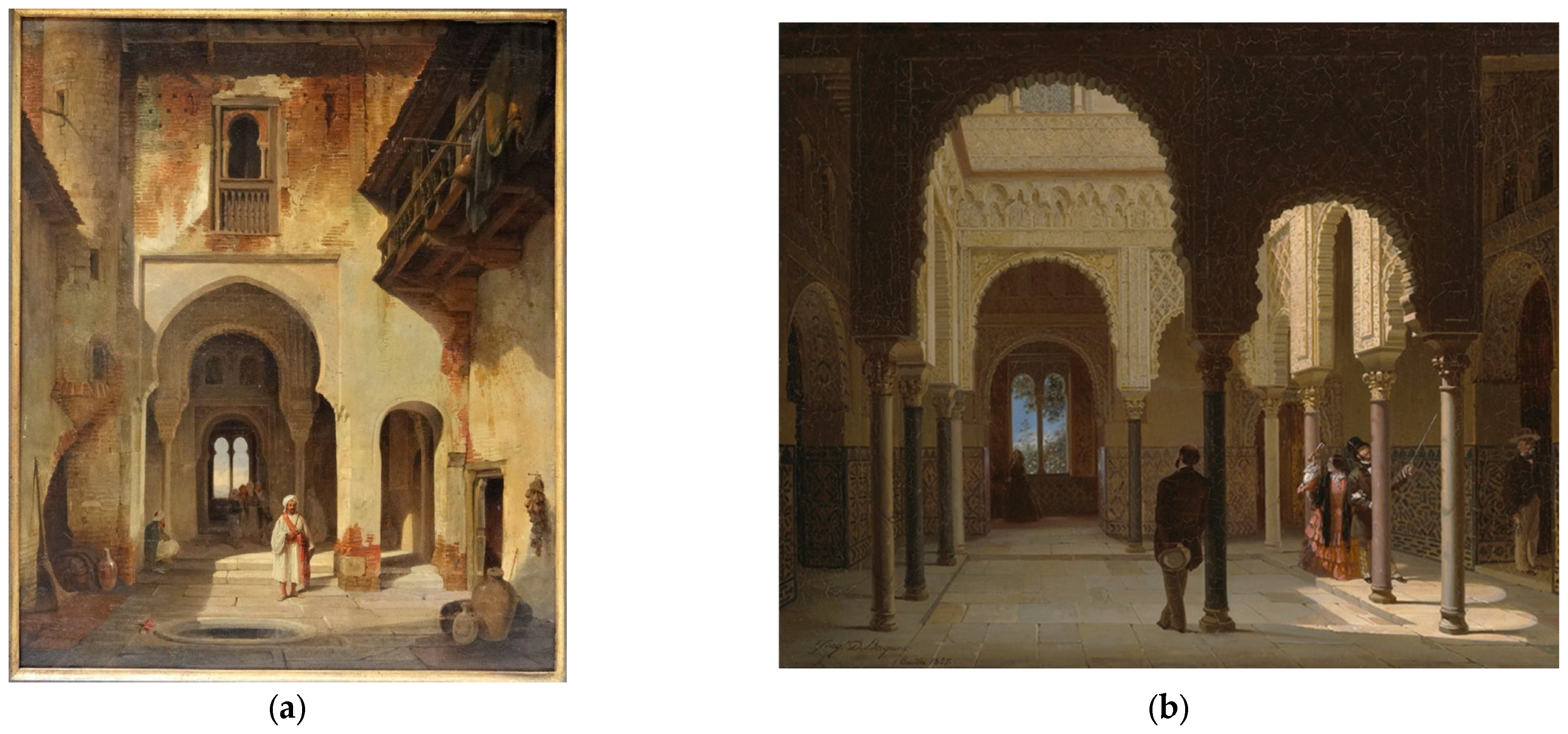
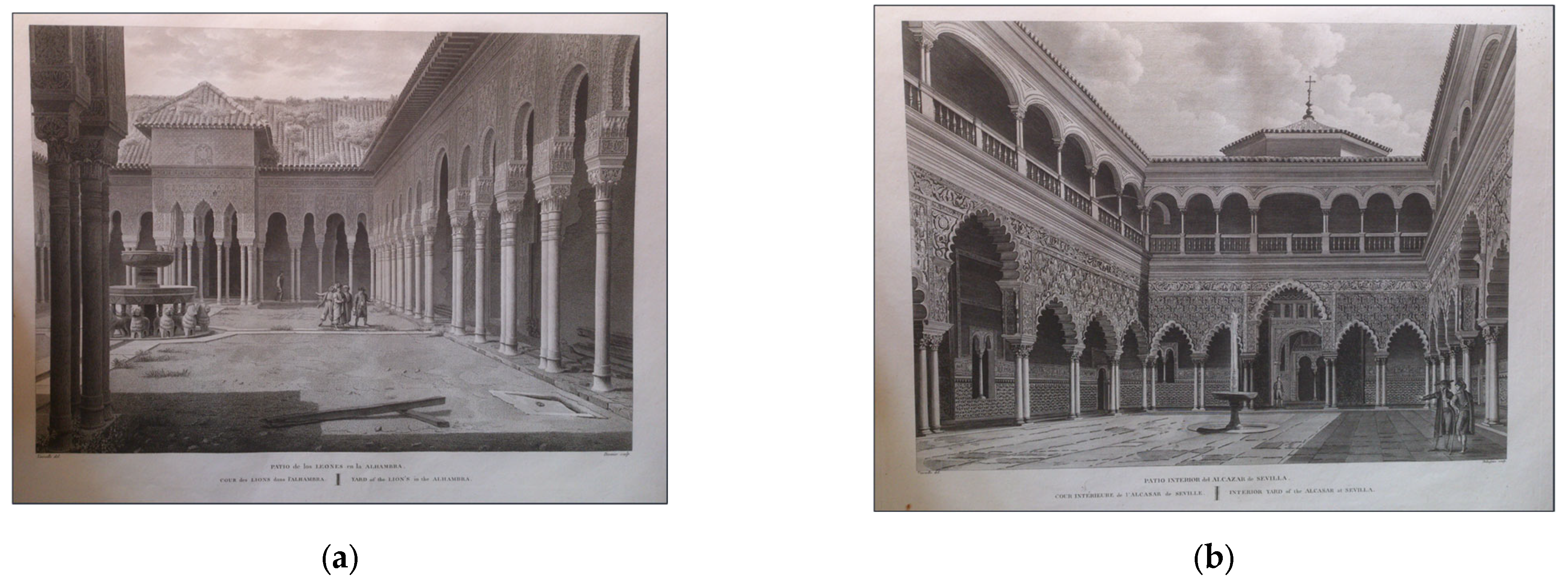
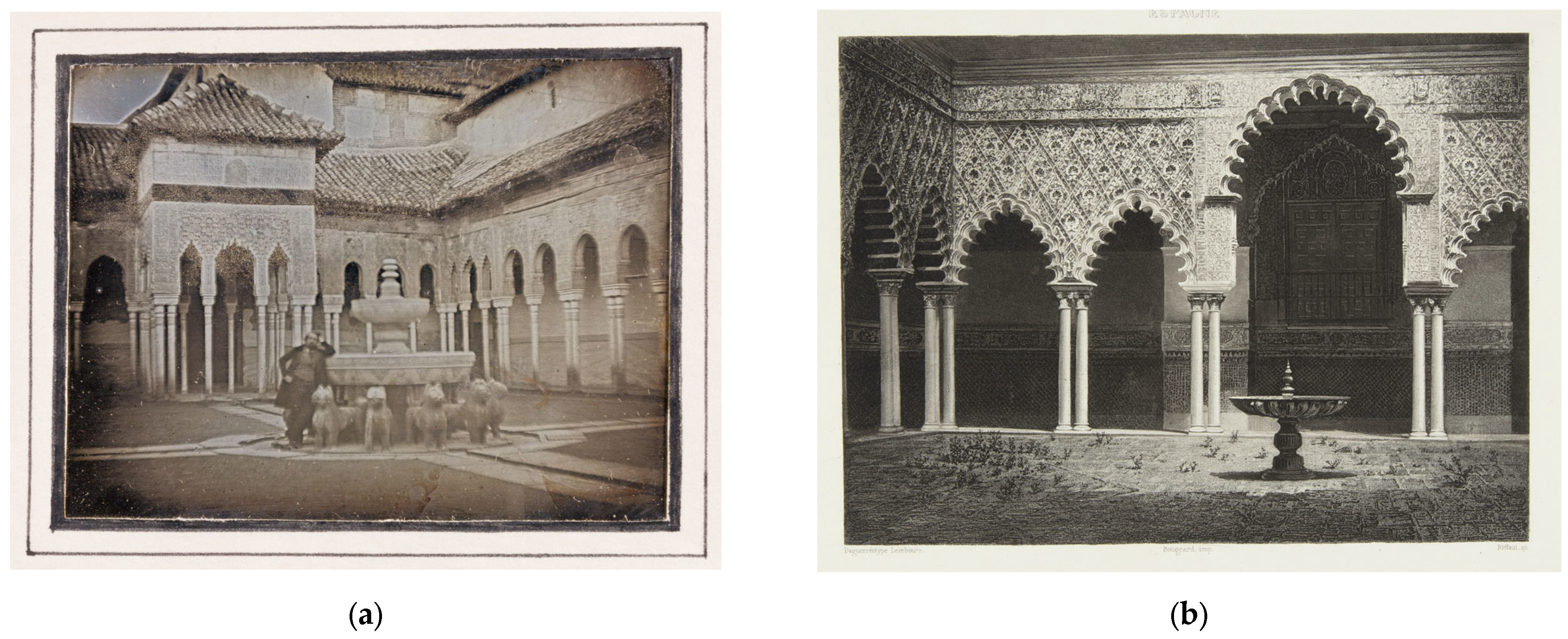
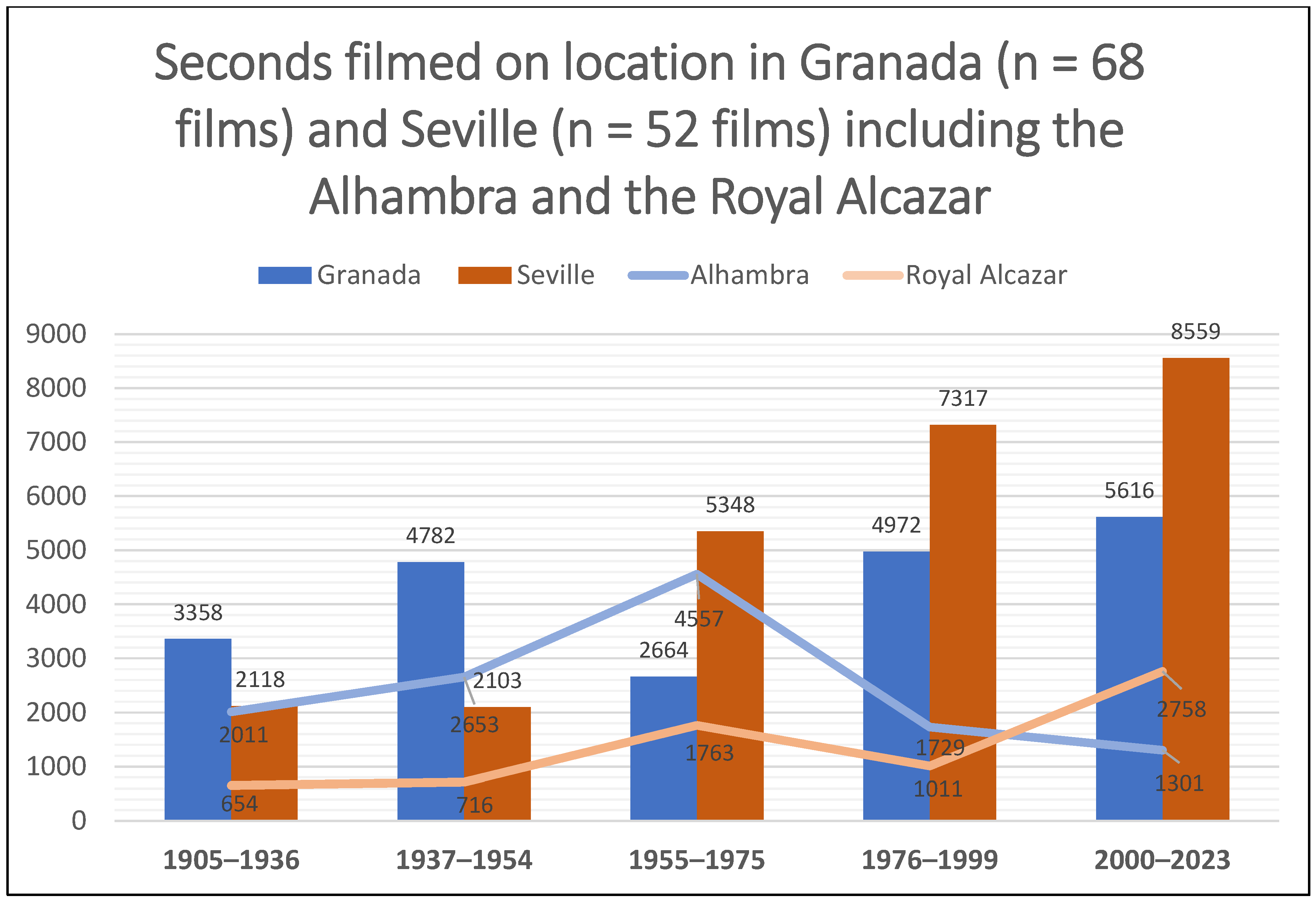
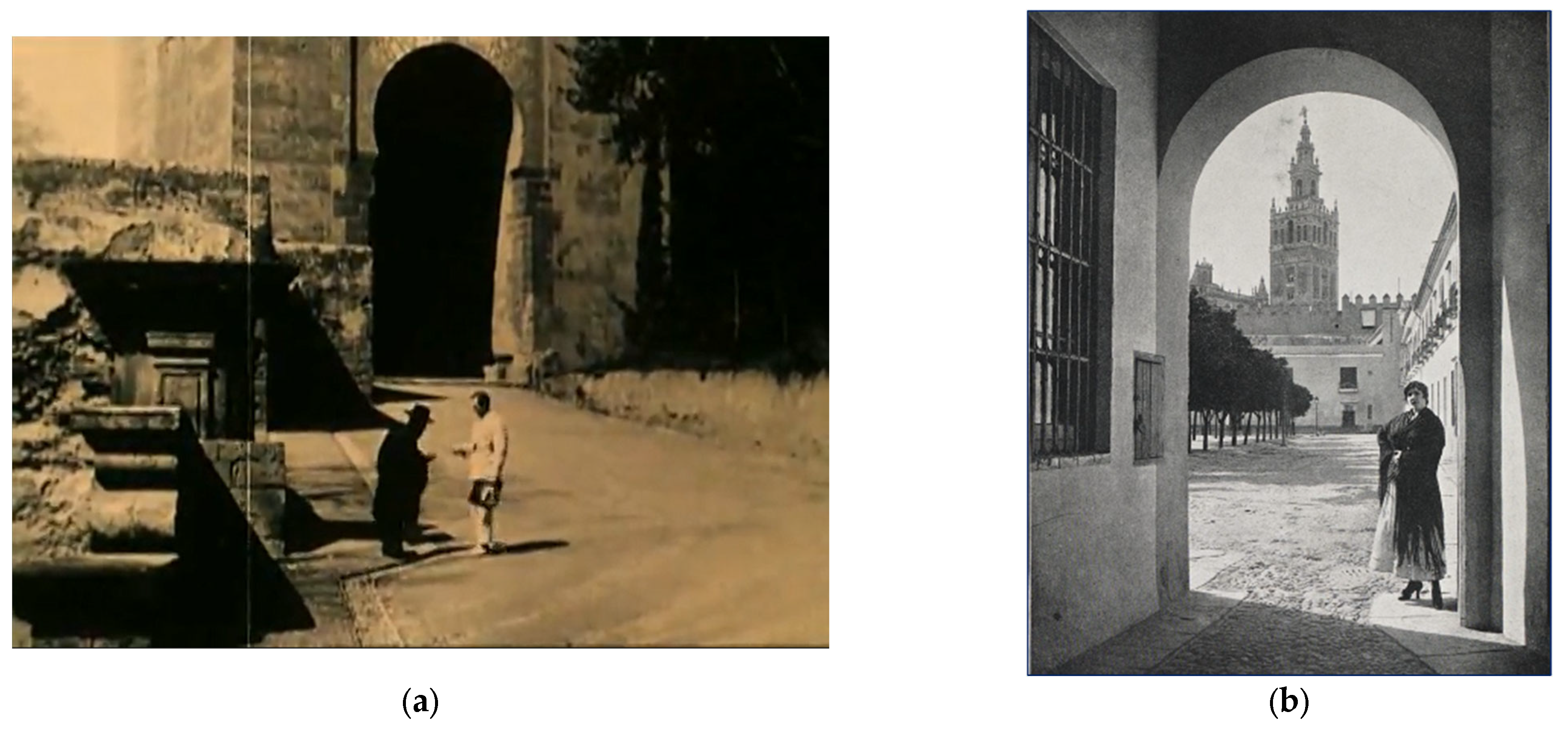
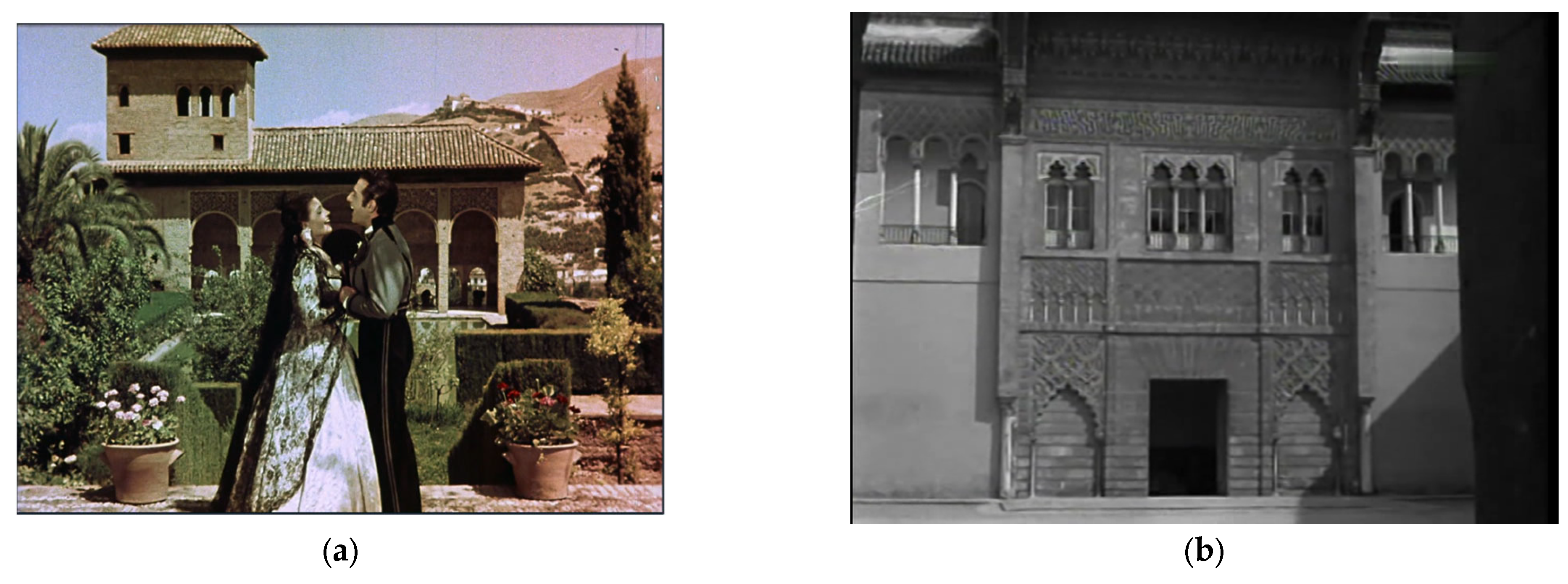
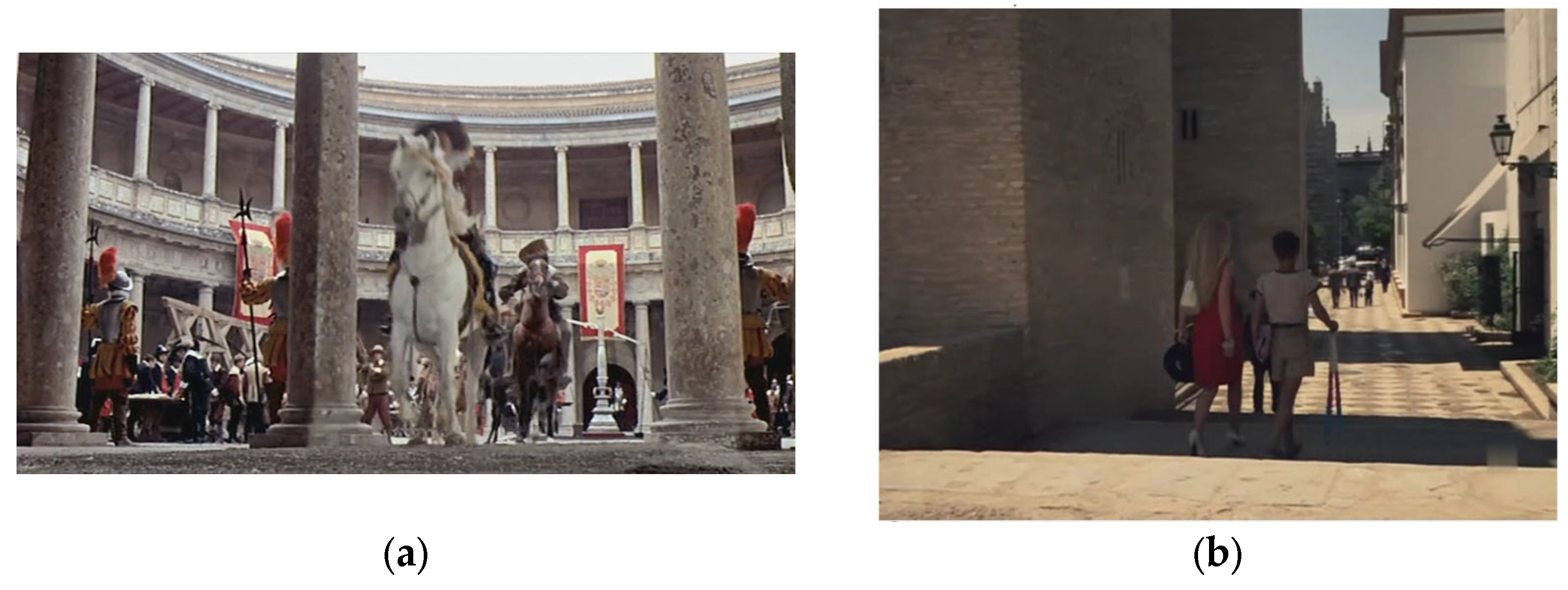


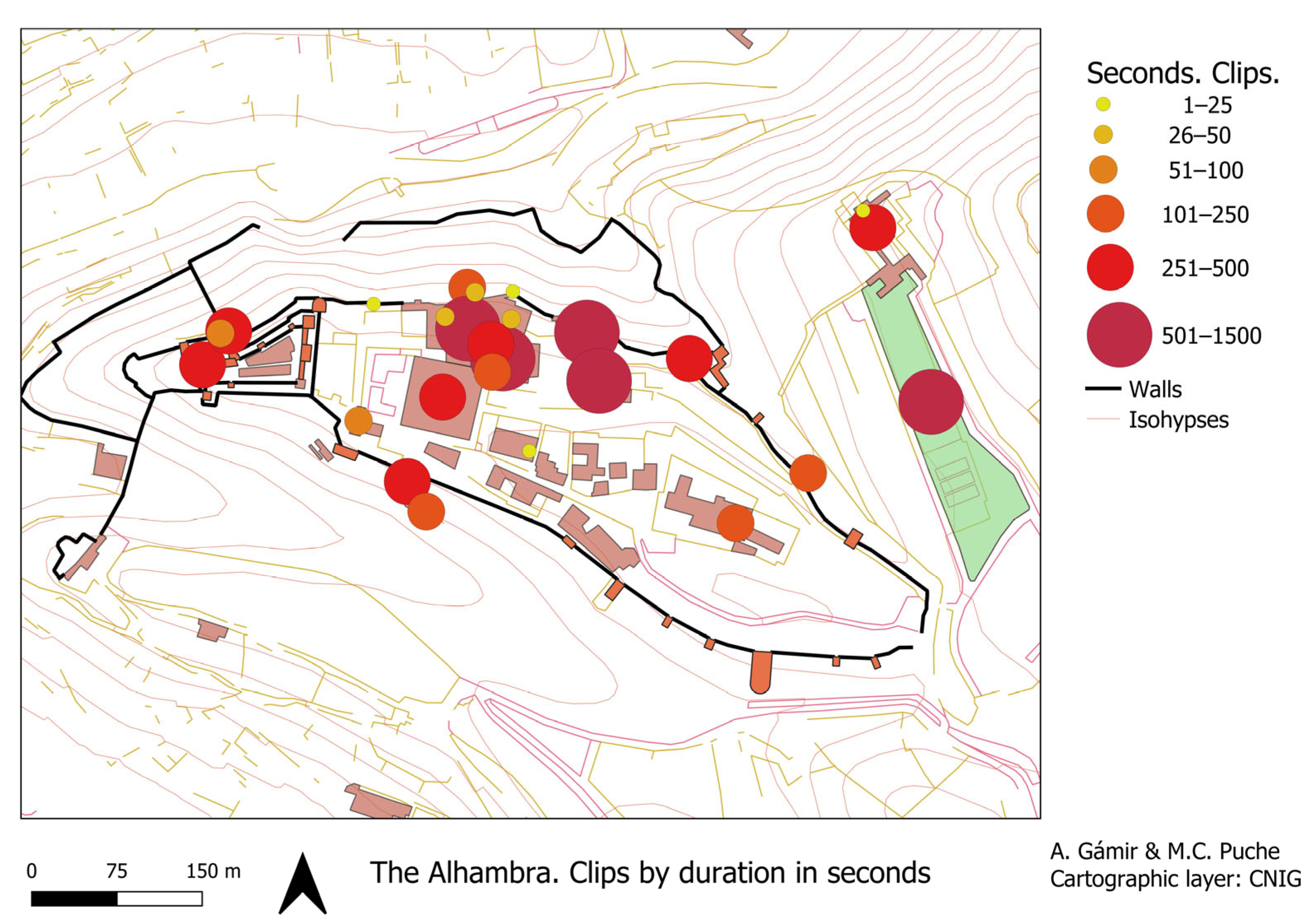
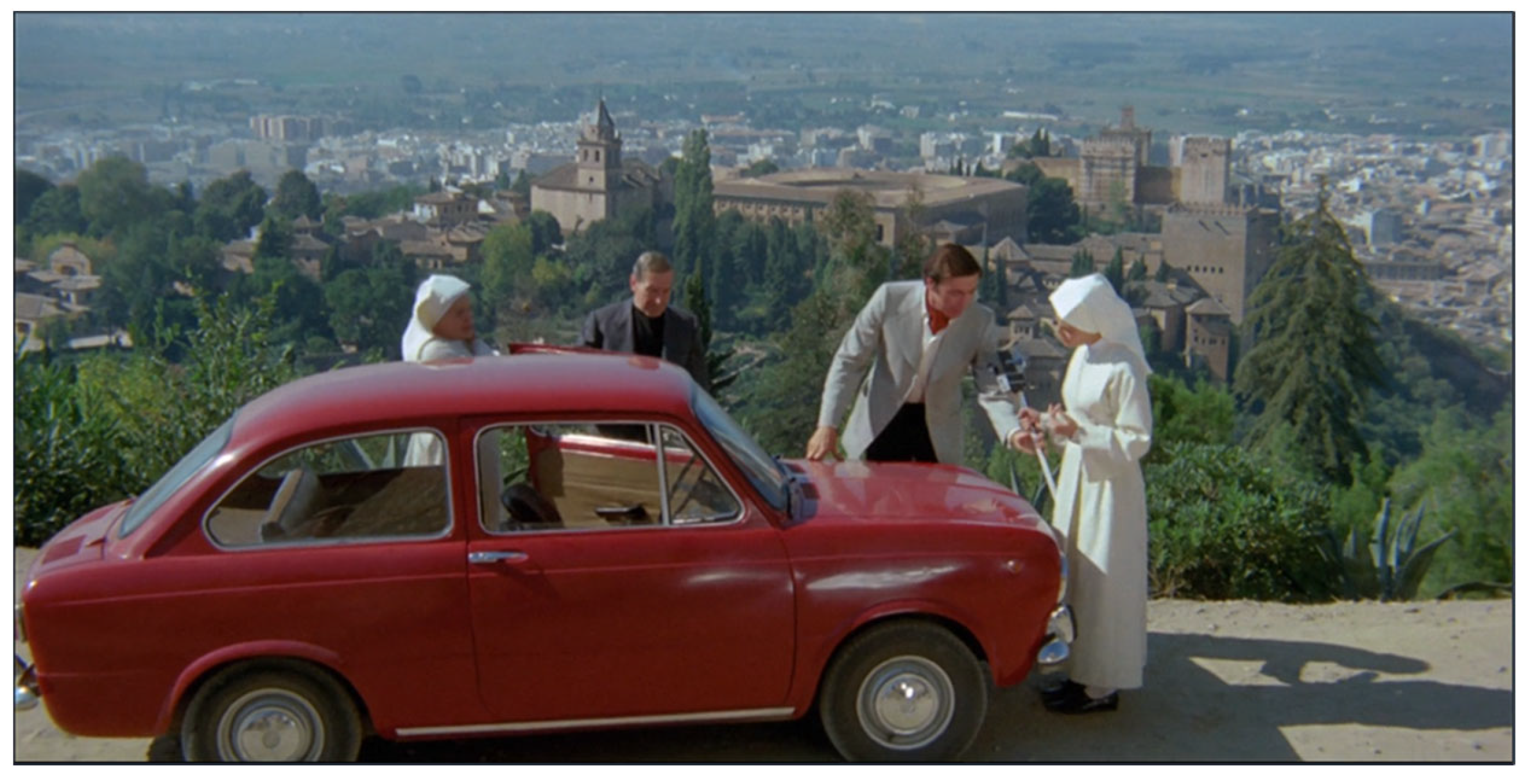
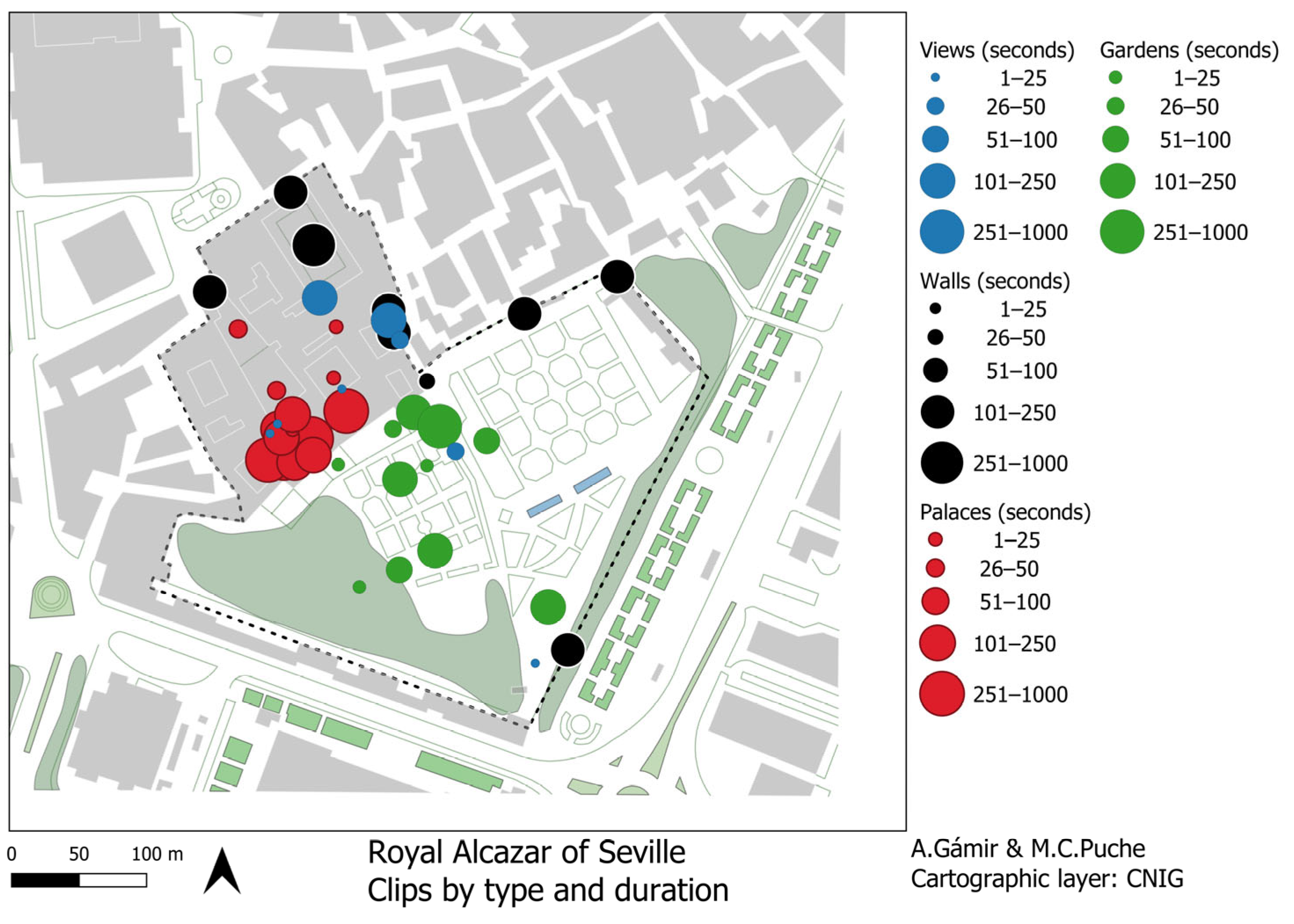
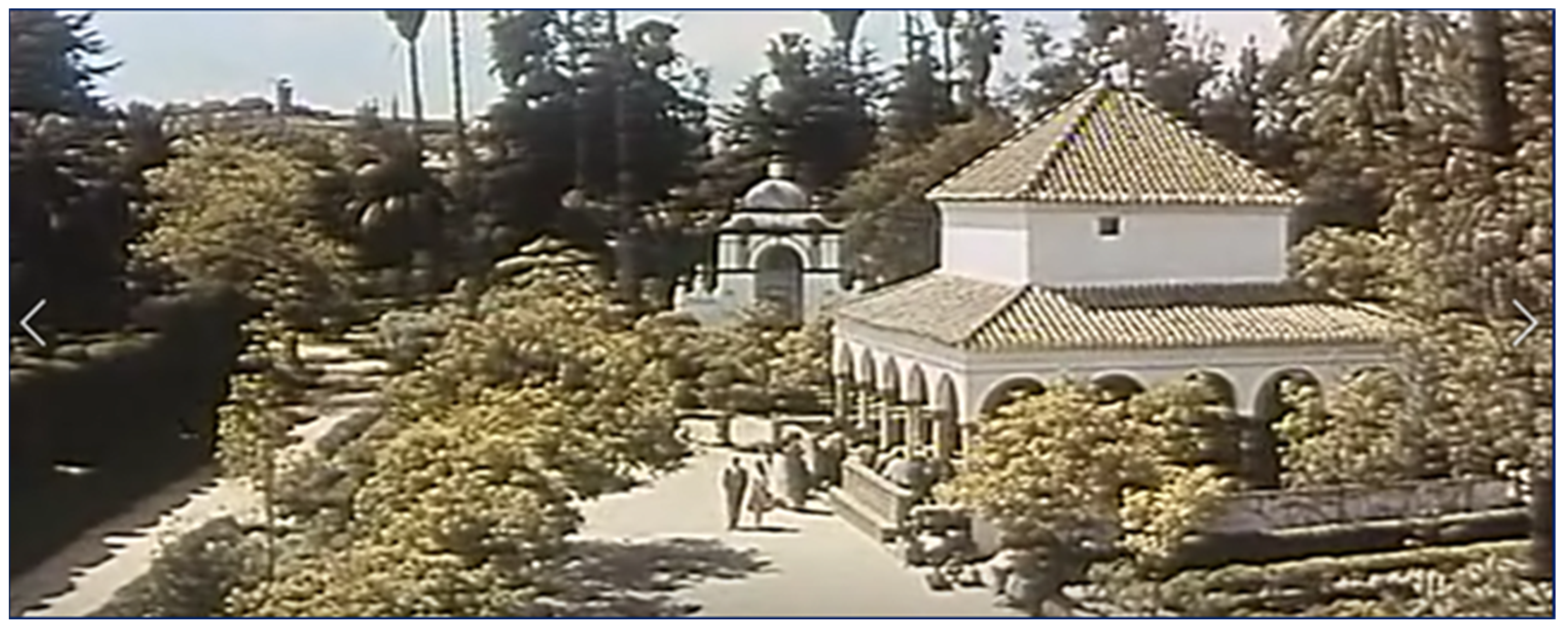
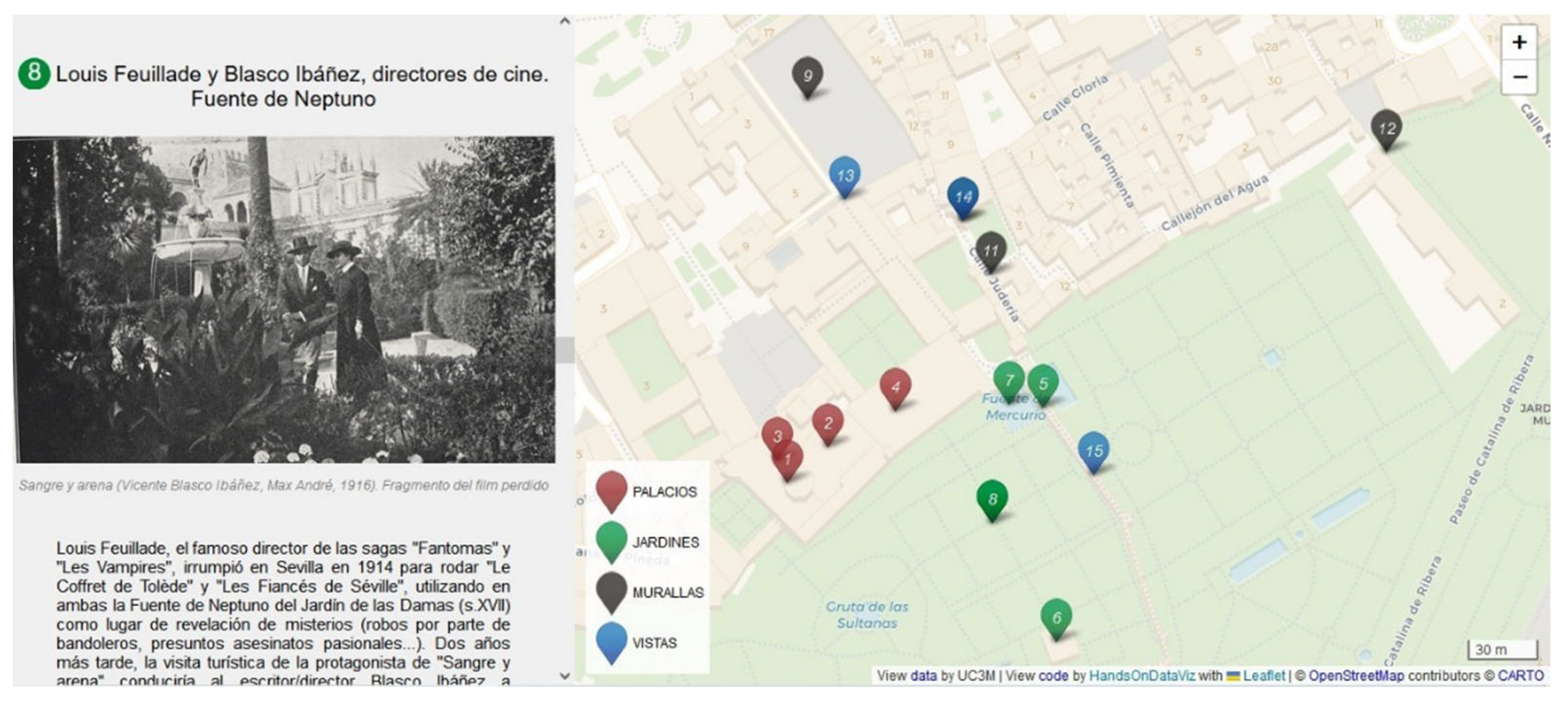
| Alhambra | Duration | Royal Alcazar | Duration |
|---|---|---|---|
| Court of the Lions | 24:21 | Maidens Courtyard | 14:51 |
| Partal | 12:58 | Hall of Ambassadors | 12:55 |
| Generalife Gardens | 11:04 | Philip II Ceiling Room | 09:08 |
| Yusuf III Gardens-Partal | 10:06 | Patio de Banderas | 08:04 |
| Comares Palace | 09:52 | Gothic Palace and Tapestries Hall | 07:50 |
| Gate of Justice | 08:03 | Grotto Gallery | 04:39 |
Disclaimer/Publisher’s Note: The statements, opinions and data contained in all publications are solely those of the individual author(s) and contributor(s) and not of MDPI and/or the editor(s). MDPI and/or the editor(s) disclaim responsibility for any injury to people or property resulting from any ideas, methods, instructions or products referred to in the content. |
© 2023 by the authors. Licensee MDPI, Basel, Switzerland. This article is an open access article distributed under the terms and conditions of the Creative Commons Attribution (CC BY) license (https://creativecommons.org/licenses/by/4.0/).
Share and Cite
Puche-Ruiz, M.C.; Gámir, A. Audiovisual Fiction and World Heritage Sites in Medium-Sized Spanish Cities: The Alhambra of Granada and the Royal Alcazar of Seville (1905–2023). Sustainability 2023, 15, 7402. https://doi.org/10.3390/su15097402
Puche-Ruiz MC, Gámir A. Audiovisual Fiction and World Heritage Sites in Medium-Sized Spanish Cities: The Alhambra of Granada and the Royal Alcazar of Seville (1905–2023). Sustainability. 2023; 15(9):7402. https://doi.org/10.3390/su15097402
Chicago/Turabian StylePuche-Ruiz, Maria C., and Agustín Gámir. 2023. "Audiovisual Fiction and World Heritage Sites in Medium-Sized Spanish Cities: The Alhambra of Granada and the Royal Alcazar of Seville (1905–2023)" Sustainability 15, no. 9: 7402. https://doi.org/10.3390/su15097402
APA StylePuche-Ruiz, M. C., & Gámir, A. (2023). Audiovisual Fiction and World Heritage Sites in Medium-Sized Spanish Cities: The Alhambra of Granada and the Royal Alcazar of Seville (1905–2023). Sustainability, 15(9), 7402. https://doi.org/10.3390/su15097402






